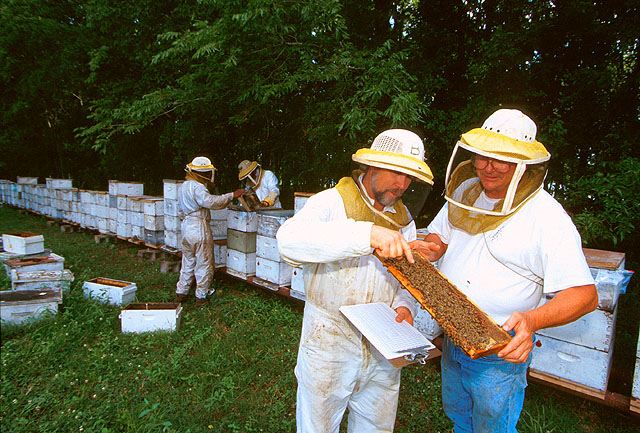WINTER HONEY BEE LOSSES DECLINE

But Losses Remain Too High, Says UMD Expert
COLLEGE PARK, Md. – Total losses of managed honey bee colonies from all causes dropped to 21.9 percent nationwide for the 2011/2012 winter, a decline of some 8 percentage points or 27 percent from the approximately 30 percent average loss beekeepers have experienced in recent winters, according to the latest annual survey conducted by the Bee Informed Partnership, the Apiary Inspectors of America and the United States Department of Agriculture (USDA).
“This is certainly an improvement over recent years, but it is still far too high a loss rate,” says University of Maryland’s Dennis vanEngelsdorp, the leader of the survey and a research scientist in the department of entomology at Maryland. “One in five bees lost is still huge and still quite a ways from the 13-14 percent loss that beekeepers say would be sustainable” says vanEngelsdorp, who authored the preliminary report on the groups’ survey findings.
Understanding the health of bees and other native pollinators is important to ecosystems and our economy because of the crucial role pollinators play in plant reproduction. It is estimated that bees pollinate about a third of the food that we eat, at a value of about $15 billion per year.
The groups’ surveys for the previous five years found total colony losses of 30 percent in 2010/2011, 34 percent in 2009/2010, 29 percent in 2008/2009, 36 percent in 2007/2008 and 32 percent in 2006/2007.
vanEngelsdorp and other scientists involved in the survey say they don’t know the reason for improved bee survival this winter, but that the unusually warm winter during 2011/2012 is one possible contributing factor. January 2012 ranks as the fourth warmest January in U.S. history. However they say no direct scientific investigation of the weather connection has been done.
“A warm winter means less stress on bee colonies and may help them be more resistant to pathogens, parasites and other problems,” said Jeff Pettis, co-leader of the survey and research leader of the Agricultural Research Service (ARS) Bee Research Laboratory in Beltsville, Md. ARS is USDA’s chief intramural scientific research agency.
Of beekeepers who reported losing any colonies, 37 percent said they lost at least some of their colonies without the presence of dead bees, which is one of the defining symptoms of colony collapse disorder (CCD), a serious problem that beekeepers began facing in 2006. Since this was an interview-based survey, it was not possible to confirm that these colonies had CCD or if the losses were the result of other causes that share the "absence of dead bees" symptom.
Beekeepers who reported colony losses with no dead bees present had average colony losses of 47 percent, compared to beekeepers who lost colonies, but did report dead bees. Those beekeepers lost 19 percent of their colonies.
Last year, beekeepers who reported colony losses with no dead bee bodies present had average colony losses of 61 percent, compared to beekeepers who lost colonies but did report dead bees. They had 34 percent in losses.
“Despite intense efforts we still don’t fully understand why bees are dying at such high rates,” vanEngelsdorp says, “It seems likely that several factors, including pesticides, parasitic mites and diseases, and nutrition problems all play a contributing roll.”
Almost half of responding beekeepers reported losses greater than 13.6 percent, the level of loss that beekeepers have stated would be acceptable for their operations. Continued losses above that level threaten the economic sustainability of commercial beekeeping
A total of 5,543 U.S. beekeepers, approximately 20 percent of the beekeepers in the United States, responded to the online survey. Collectively, the responding beekeepers managed over 14.6 percent of the country’s estimated 2.49 million colonies. A complete analysis of the survey data will be published later this year. The abstract can be found at: http://beeinformed.org/2012/05/winter2012/.
Science Contact:
Dennis vanEngelsdorp
Research Scientist
Email: dennis.vanengelsdorp@gmail.com
Office Phone: 301-405-3942
More information about colony collapse disorder can be found at www.ars.usda.gov/ccd.
The Bee Informed Partnership is funded by the National Institute of Food and Agriculture, USDA.
About the University of Maryland
The University of Maryland is the state's flagship university and one of the nation's preeminent public research universities. Ranked No. 17 among public universities by U.S. News & World Report, it has 30 academic programs in the U.S News Top 10 and 71 in the Top 25. The Institute of Higher Education (Jiao Tong University, Shanghai), which ranks the world's top universities based on research, puts Maryland at No. 38 in the world and No. 13 among U.S. public universities. For the fourth consecutive year, the University of Maryland ranked in the top 10 of Kiplinger's Personal Finance magazine's list of Best Values in Public Colleges for 2011-12.The university has produced six Nobel laureates, seven Pulitzer Prize winners, more than 40 members of the national academies and scores of Fulbright scholars. The university is recognized for its diversity, with underrepresented students comprising one-third of the student population. For more information about the University of Maryland, visit www.umd.edu.
Tags:


